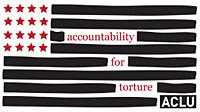In 2001, I told the Criminal Division, which was advising the FBI in Afghanistan, that Lindh could not be interrogated without his counsel. That was on a Friday. The Criminal Division called back on Monday and said that the FBI had interrogated him anyway. They wanted to know what to do. I advised that the interview would have to be sealed and used only for national security purposes or intelligence-gathering, not criminal prosecution. Again, my advice was ignored.The Justice Department OIG is a limited hangout, i.e., an admission of some crimes, but a cover-up of the total barbaric scenario unfolding in Bush's torture prisons. For a heart-rending but comprehensive look at what these detainees have endured, I strongly recommend Murnat Kurnaz's memoir, Five Years of My Life: An Innocent Man in Guantanamo.
Three months later, I inadvertently learned of a discovery order, which had been deliberately concealed from me, for all Justice Department correspondence related to Lindh's interrogation. When I went to comply, my e-mails had been purged from the file. With the help of technical support, I recovered them from my computer, turned them over to my boss, took home a copy in case they "disappeared" again, and resigned.
As the criminal case barreled toward trial, the Justice Department continued to assert that Lindh was never represented by counsel and that his rights had been "carefully, scrupulously guarded." I did not believe the Justice Department would have the temerity to make public statements contradicted by its own court filings if my e-mails had indeed reached the court. So I blew the whistle, which unleashed a torrent of retaliation....
In 2002, my lawyer made it abundantly clear to the OIG that I took several steps to thwart efforts to conceal material regarding Lindh's interrogation from the court. In January 2003, Inspector General Glenn Fine, who issued the recent FBI report, told my attorney that the OIG had looked into my whistleblower allegations and was not going to pursue them. (OIG did not look too searchingly because it did not even bother to interview me, the complainant.) To add insult to injury, OIG turned my case over for criminal prosecution, which eventually closed with no charges ever being brought. But the Justice Department was not through with me yet. It put me on the "No-Fly List" and referred me to the state bars in which I'm licensed as an attorney, based on a secret report - by the OIG - to which I did not have access. [emphasis in original]
A few excerpts from Kurnaz's book:
I looked around. This was truly nothing more than a ship's container with a door. The walls were reinforced by corrugated metal sheeting like the one in fairground stalls. Every surface -- the walls, the floor, the ceiling -- was covered with it. There was no mattress or wool blanket. A toilet and a sink were sunk into the floor. If I stared for too long at any one point of the metal sheeting I got dizzy....
The light went off. It was cold. The metal on the floor felt like ice.... I heard a rumbling. It was an air-conditioning unit mounted above the door. Icy air streamed in.... They've put me in a giant refrigerator.
After a while, I couldn't feel my hands or legs....
Sometimes I had to move to stop the cold, but I tried not to. I needed to save my energy since all I was given to eat was a piece of toast and a bit of apple, three times a day. but I had to move around sometimes, when it got colder.....
In late 2002, General Geoffrey Miller took over command of Guantanamo, and our situation dramatically worsened. The interrogations got more brutal, more frequent, and longer....
I was moved from one block to the next. The escort team would storm in, put me in chains, run with me through the corridors, push me to my knees, and leave me there. The whole procedure would be repeated an hour later.... I had to stand and kneel -- twenty-four hours a day....
In between transfers, I was interrogated... I estimated the sessions lasted up to fifteen hours.... I sat chained to my chair, or kneeling on the floor, and as soon as my eyelids drooped, soldiers would wake me with a couple of blows. (pp. 161-177)









No comments:
Post a Comment